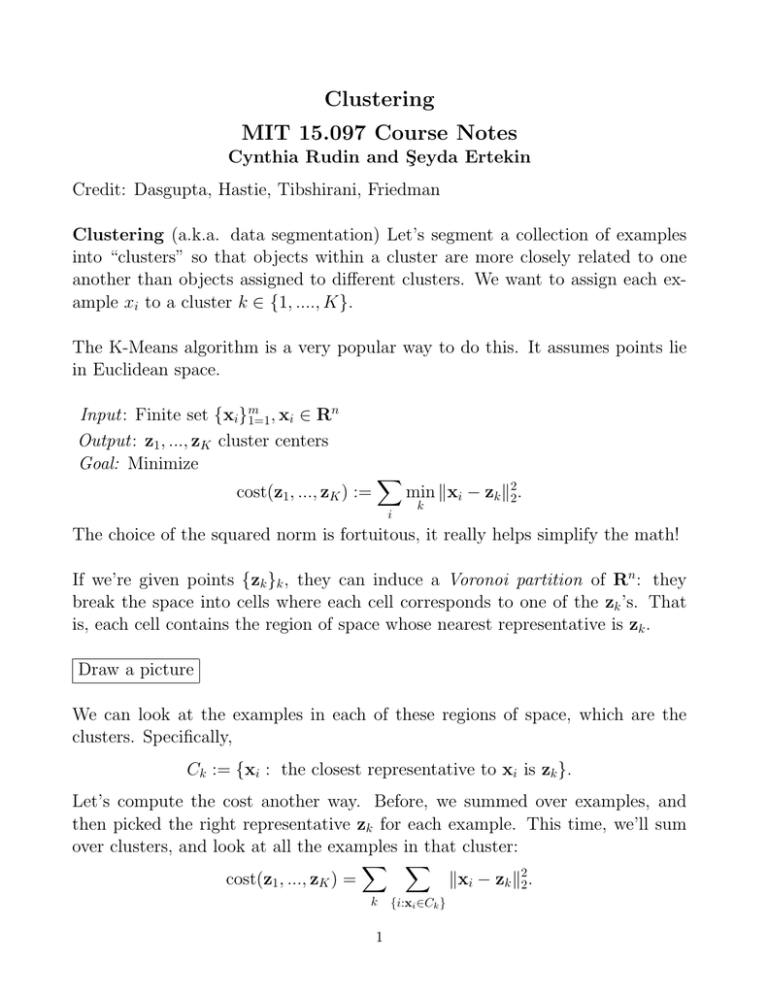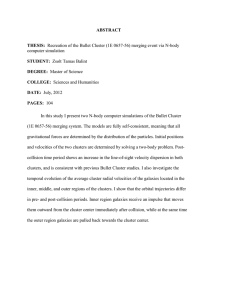
Clustering
MIT 15.097 Course Notes
Cynthia Rudin and Şeyda Ertekin
Credit: Dasgupta, Hastie, Tibshirani, Friedman
Clustering (a.k.a. data segmentation) Let’s segment a collection of examples
into “clusters” so that objects within a cluster are more closely related to one
another than objects assigned to different clusters. We want to assign each ex­
ample xi to a cluster k ∈ {1, ...., K}.
The K-Means algorithm is a very popular way to do this. It assumes points lie
in Euclidean space.
n
Input: Finite set {xi }m
1=1 , xi ∈ R
Output: z1 , ..., zK cluster centers
Goal: Minimize
min Ixi − zk I22 .
cost(z1 , ..., zK ) :=
i
k
The choice of the squared norm is fortuitous, it really helps simplify the math!
If we’re given points {zk }k , they can induce a Voronoi partition of Rn : they
break the space into cells where each cell corresponds to one of the zk ’s. That
is, each cell contains the region of space whose nearest representative is zk .
Draw a picture
We can look at the examples in each of these regions of space, which are the
clusters. Specifically,
Ck := {xi : the closest representative to xi is zk }.
Let’s compute the cost another way. Before, we summed over examples, and
then picked the right representative zk for each example. This time, we’ll sum
over clusters, and look at all the examples in that cluster:
Ixi − zk I22 .
cost(z1 , ..., zK ) =
k
1
{i:xi ∈Ck }
While we’re analyzing, we’ll need to consider suboptimal partitions of the data,
where an example might not be assigned to the nearest representative. So we
redefine the cost:
X X
cost(C1 , ..., CK ; z1 , ..., zK ) =
kxi − zk k22 .
(1)
k
{i:xi ∈Ck }
Let’s say we only have one cluster to deal with. Call it C. The representative is
z. The cost is then:
X
cost(C; z) =
kxi − zk22 .
{i:xi ∈C }
Where should we place z?
As you probably guessed, we would put it at the mean of the examples in C. But
also, the additional cost incurred by picking z 6= mean(C) can be characterized
very simply:
Lemma 1. For any set C ⊂ Rn and any z ∈ Rn ,
cost(C; z) = cost(C, mean(C)) + |C | · kz − mean(C)k22 .
Let’s go ahead and prove it. In order to do that, we need to do another biasvariance decomposition (this one’s pretty much identical to one of the ones we
did before).
Lemma 2. Let X ∈ Rn be any random variable. For any z ∈ Rn , we have:
EX kX − zk22 = EX kX − EX Xk22 + kz − EX Xk22 .
Proof. Let x̄ := EX X.
EX kX − zk22 = EX
X
= EX
X
= EX
X
(X (j) − z (j) )2
j
(X (j) − x̄(j) + x̄(j) − z j )2
j
(X
(j)
j
+2EX
(j) 2
− x̄ ) + EX
X
(x̄(j) − z j )2
j
X
(X (j) − x̄(j) )(x̄(j) − z (j) )
j
= EX kX − x̄k22 + EX kx̄ − zk22 + 0. 2
To prove Lemma 1, pick a specific choice for X, namely X is a uniform random
draw from the points xi in set C. So X has a discrete distribution. What will
happen with this choice of X is that the expectation will reduce to the cost we
already defined above.
X
EX kX − zk22 =
(prob. that point i is chosen)kxi − zk22
{i:xi ∈C }
=
X
{i:xi ∈C}
1
1
kxi − zk22 =
cost(C, z)
|C |
|C|
(2)
and if we use Lemma 2 substituting z to be x̄ (a.k.a., EX X, or mean(C)) and
simplify as in (2):
EX kX − x̄k22 =
1
cost(C, mean(C)).
|C |
(3)
We had already defined cost earlier, and the choice of X was nice because its
expectation is just the cost. Let’s recopy Lemma 2’s statement here, using the
x̄ notation:
EX kX − zk22 = EX kX − x̄k22 + kz − x̄k22 .
Plugging in (2) and (3),
1
1
cost(C, z) =
cost(C, mean(C)) + kz − x̄k22 .
|C|
|C |
(4)
Multiplying through,
cost(C; z) = cost(C, mean(C)) + |C| · kz − mean(C)k22 .
And that’s the statement of Lemma 1. To really minimize the cost (1), you’d need to try all possible assignments of the
m data points to K clusters. Uck! The number of distinct assignments is (Jain
and Dubes 1988):
K
1 X
K m
S(m, K) =
(−1)K−k
k
K!
k
k=1
S(10, 4) = 34K, S(19, 4) ≈ 1010 , ...
so not doable.
Let’s try some heuristic gradient-descent-ish method instead.
3
The K-Means Algorithm
Choose the value of K before you start.
Initialize centers
Repeat until there
for each k:
for each k:
z1 , ..., zK ∈ Rn and clusters C1 , ..., CK in any way.
is no further change in cost:
Ck ← {xi : the closest representative is zk }
zk = mean(Ck )
This is simple enough, and takes O(Km) time per iteration.
PPT demo
Of course, it doesn’t always converge to the optimal solution.
But does the cost converge?
Lemma 3. During the course of the K-Means algorithm, the cost monotonically
decreases.
(t)
(t)
(t)
(t)
Proof. Let z1 , ..., zK , C1 , ..., CK denote the centers and clusters at the start of
the tth iterate of K-Means. The first step of the iteration assigns each data point
to its closest center, therefore, the cluster assignment is better:
(t+1)
cost(C1
(t+1)
, ..., CK
(t)
(t)
(t)
(t)
(t)
(t)
, z1 , ..., zK ) ≤ cost(C1 , ..., CK , z1 , ..., zK ).
On the second step, each cluster is re-centered at its mean, so the representatives
are better. By Lemma 1,
(t+1)
cost(C1
(t+1)
, ..., CK
(t+1)
, z1
(t+1)
, ..., zK
(t+1)
) ≤ cost(C1
•
So does the cost converge?
4
(t+1)
, ..., CK
(t)
(t)
, z1 , ..., zK ).
Example of how K-Means could converge to the wrong thing
How might you make K-Means more likely to converge to the optimal?
How might you choose K? (Why can’t you measure test error?)
Other ways to evaluate clusters (“cluster validation”)
There are loads of cluster validity measures, alternatives to the cost. Draw a picture
• Davies-Baldwin Index - looks at average intracluster distance (within-cluster
distance) to the centroid (want it to be small), and intercluster distances
between centroids (want it to be large).
• Dunn Index - looks pairwise at minimal intercluster distance (want it to be
large) and maximal intracluster distance (want it to be small).
Example: Microarray data. Have 6830 genes (rows) and 64 patients (columns).
The color of each box is a measurement of the expression level of a gene. The
expression level of a gene is basically how much of its special protein it is pro­
ducing. The physical chip itself doesn’t actually measure protein levels, but a
proxy for them (which is RNA, which sticks to the DNA on the chip). If the
color is green, it means low expression levels, if the color is red, it means higher
expression levels. Each patient is represented by a vector, which is the expression
level of their genes. It’s a column vector with values given in color:
5
© source unknown. All rights reserved. This content is excluded from our Creative
Commons license. For more information, see http://ocw.mit.edu/fairuse.
Sum of Squares (104)
Each patient (column) has some type of cancer. Want to cluster patients to see
whether patients with the same types of cancers cluster together. So each cluster
center is an “average” patient expression level vector for some type of cancer.
It’s also a column vector
26
24
22
20
18
16
2
4
6
8
10
Number of Clusters K
Hm, there’s no kink in this figure. Compare K = 3 solution with “true” clusters:
Cluster
Breast
CNS
Colon
K562
Leukemia
MCF7
1
3
5
0
0
0
0
2
2
0
0
2
6
2
3
2
0
7
0
0
0
Cluster
Melanoma
NSCLC
Ovarian
Prostate
Renal
Unknown
1
1
7
6
2
9
1
2
7
2
0
0
0
0
3
0
0
0
0
0
0
Images by MIT OpenCourseWare, adapted from Hastie et al., The Elements of Statistical Learning,
Springer, 2009.
6
It’s pretty good at keeping the same cancers in the same cluster. The two breast
cancers in the 2nd cluster were actually melanomas that metastasized.
Generally we cluster genes, not patients. Would really like to get something like
this in practice:
Courtesy of the Rockefeller University Press. Used with permission.
Figure 7 from Rumfelt, Lynn, et al. "Lineage Specification and Plasticity in CD19- Early B
cell Precursors." Journal of Experimental Medicine 203 (2006): 675-87.
where each row is a gene, and the columns are different immune cell types.
A major issue with K-means: as K changes, cluster membership can change
arbitrarily. A solution is Hierarchical Clustering.
• clusters at the next level of the hierarchy are created by merging clusters at
the next lowest level.
– lowest level: each cluster has 1 example
– highest level: there’s only 1 cluster, containing all of the data.
7
NSCLC
BREAST
COLON
COLON
COLON
COLON
COLON
NSCLC
NSCLC
COLON
COLON
MCF7D-repro
BREAST
MCF7A-repro
BREAST
BREAST
CNS
CNS
CNS
CNS
CNS
PROSTATE
OVARIAN
PROSTATE
NSCLC
NSCLC
NSCLC
OVARIAN
OVARIAN
NSCLC
RENAL
RENAL
RENAL
RENAL
RENAL
RENAL
RENAL
MELANOMA
NSCLC
RENAL
OVARIAN
UNKNOWN
OVARIAN
OVARIAN
RENAL
NSCLC
BREAST
MELANOMA
MELANOMA
MELANOMA
MELANOMA
MELANOMA
MELANOMA
MELANOMA
LEUKEMIA
LEUKEMIA
LEUKEMIA
LEUKEMIA
LEUKEMIA
BREAST
BREAST
K562A-repro
K562B-repro
LEUKEMIA
Image by MIT OpenCourseWare, adapted from Hastie et al., The Elements of
Statistical Learning, Springer, 2009.
Application Slides
8
MIT OpenCourseWare
http://ocw.mit.edu
15.097 Prediction: Machine Learning and Statistics
Spring 2012
For information about citing these materials or our Terms of Use, visit: http://ocw.mit.edu/terms.


